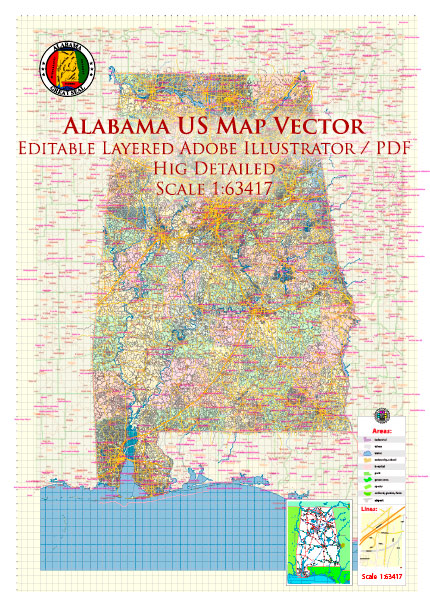Climate and soil
The climate of Alabama is humid subtropical.
The heat of summer is tempered in the south by the winds from the Gulf of Mexico, and in the north by the
elevation above the sea. The average annual temperature is highest in the southwest along the coast, and lowest
in the northeast among the highlands. Thus at Mobile the annual mean is 67 °F (19 °C), the mean for the
summer 81 °F (27 °C), and for the winter 52 °F (11 °C); and at Valley Head, in De Kalb county, the annual
mean is 59 °F (15 °C), the mean for the summer 75 °F (24 °C), and for the winter 41 °F (5 °C). At Montgomery,
in the central region, the average annual temperature is 66 °F (19 °C), with a winter average of 49 °F (9 °C),
and a summer average of 81 °F (27 °C). The average winter minimum for the entire state is 35 °F (2 °C),
and there is an average of 35 days in each year in which the thermometer falls below the freezing-point.
At extremely rare intervals the thermometer has fallen below zero (-18 °C), as was the case in the remarkable
cold wave of the 12th-13 February 1899, when an absolute minimum of −17 °F (−27 °C) was registered at Valley Head.
The highest temperature ever recorded was 109 °F (43 °C) in Talladega county in 1902.
The amount of precipitation is greatest along the coast (62 inches/1,574 mm) and evenly distributed through
the rest of the state (about 52 inches/1,320 mm). During each winter there is usually one fall of snow
in the south and two in the north; but the snow quickly disappears, and sometimes, during an entire winter,
the ground is not covered with snow. Heavy snowfall can occur, such as during the New Year’s Eve 1963 snowstorm
and the 1993 Storm of the Century. Hailstorms occur occasionally in the spring and summer, but are seldom destructive.
Heavy fogs are rare, and are confined chiefly to the coast. Thunderstorms occur throughout the year – they
are most common in the summer, but most severe in the spring and fall, when destructive winds and tornadoes
occasionally occur. The prevailing winds are from the news. Hurricanes are quite common in the state,
especially in the southern part, and major hurricanes occasionally strike the coast which can be very destructive.
As regards its soil, Alabama may be divided into four regions. Extending from the Gulf northward
for about 150 miles (240 km) is the outer belt of the Coastal Plain, also called the Timber Belt,
whose soil is sandy and poor, but responds well to fertilization. North of this is the inner lowland
of the Coastal Plain, or the Black Prairie, which includes some 13,000 square miles (34,000 km2)
and seventeen counties. It receives its name from its soil (weathered from the weak underlying
limestone), which is black in colour, almost destitute of sand and loam, and rich in limestone and marl
formations, especially adapted to the production of cotton; hence the region is also called the Cotton Belt.
Between the Cotton Belt and the Tennessee Valley is the mineral region, the Old Land area—a region of resistant
rocks—whose soils, also derived from weathering in silu, are of varied fertility, the best coming from the granites,
sandstones and limestones, the poorest from the gneisses, schists and slates. North of the mineral region is the
Cereal Belt, embracing the Tennessee Valley and the counties beyond, whose richest soils are the red clays
and dark loams of the river valley; north of which are less fertile soils, produced by siliceous and sandstone formations.
Source: https://en.wikipedia.org/wiki/Geography_of_Alabama


 Author: Kirill Shrayber, Ph.D.
Author: Kirill Shrayber, Ph.D.